“SYMPHONIC FUSION”
Wellington Youth Orchestra and Wellington Youth Sinfonietta
Mark Carter (WYO) and Christiaan van der Zee (WYS) – conductors
Xavier Ngaro (violin)
SUPPE – Overture “Poet and Peasant”
BRUCH – Violin Concerto No. 1 Op.26
WALTON – Suite from “Henry V”
PONCHIELLI – “Dance of the Hours” (from “La Gioconda”)
SHOSTAKOVICH – Waltz No. 2 (from “Jazz Suite”)
BIZET – “L’Arlesienne – Suite No. 2”
Alan Gibbs Centre, Wellington College, Dufferin St., Wellington
Saturday, 19th October, 2024
At a time that could be regarded as reaching an apex of dissatisfaction in a turbulent year for the capital, Wellington’s youthful orchestral musicians who make up both the Wellington Youth Orchestra and the Wellington Youth Sinfonietta came together triumphantly for a concert on Saturday afternoon at Wellington College’s Alan Gibbs Centre. The young players and their music directors demonstrated the kind of unity, strength and brilliance of purpose and achievement that comes with close co-operation and mutual understanding – a kind of example well worth emulating for those in public life! The efforts of these young musicians at once highlighted and freely gave quantities of joy and motivation and fulfilment, to the enjoyment of all present.
Wellington Youth Orchestra is the major orchestra in the region for young musicians of Grade Eight and above status, the players working with Music Director Mark Carter on a number of projects each year including a concerto award for an orchestra member who excels at a particular instrument – this year the Concerto Award was won by Xavier Ngaro, who today performed the Bruch First Violin Concerto. The orchestra’s membership is “fed” by players whose training takes place with the “other” youth ensemble in the capital, the Wellington Youth Sinfonietta, whose members have achieved a Grade Five-plus level of proficiency, and whose conductor is Christiaan Van der Zee. Both groups encourage opportunities for soloists and composers and would-be conductors to develop their skills, with the Sinfonietta occasionally collaborating with other youth ensembles from other regions in valuable combined training weekends.
A “manifestation” of all of this was Saturday’s concert, a concentrated youth-fest of artistic expression during which the musicians’ committed energies and efforts seemed to thrill its audience to pieces! – a gathering which, what was more, included people like myself who were there for the music alone, and not “connected” through any ostensible on-stage representation – in fact after the concert I walked down to the road to my car alongside a young man whom I happened to ask “how he had enjoyed the concert and whether a family member was participating” to which he replied that he had no such connection with the event but merely an interest in the programme that was being played, which, he told me, he had seen advertised, and had, upon attending, enjoyed immensely!
The older “Youth Orchestra” under Mark Carter’s direction took the stage for the first half, which opened with an item promising plenty of excitement and variety – the colourful evergreen favourite by Franz von Suppé, the Overture “Poet and Peasant”. Such a beautifully-nuanced, velvet-like brass sound at the music’s very beginning, we got here! – and answered with gorgeously-hushed strings. The orchestral tutti, as was the case all through the concert, sounded somewhat muffled due to the stage’s curtained surroundings, but it didn’t lessen the excitement of the playing, and allowed the beauty of the cello-and-harp passage which followed to make its effect, with the winds adding a gracefully-shaped melody along the way, the cellist’s awkward ascending phrase midway a shade unconfident-sounding but still resolute and determined! And what a great start there was to the allegro, with furiously buzzing strings and thunderous brass and percussion, and plenty of “snap” to the brass chording – Carter didn’t rush the players through the orchestral turmoil, but allowed it all plenty of weight and tremendous momentum, after which the famous waltz-theme glided in most beguilingly, with properly winsome textures, and with the phrasings allowing the “Viennese” charm of the music its proper effect. The closing passages of the work were no less impressively done, the strings’ “swirling figurations” leading to a scalp-tingling acceleration into the coda, and a “bringing the house down” effect at the end – great stuff!
A space then had to be cleared on the platform for a soloist for today’s concerto, which was Max Bruch’s G Minor Violin Concerto No. 1, here performed by the winner of the orchestra’s 2024 Concerto Competition, 17 year-old Xavier Ngaro from Lower Hutt, Wellington, an orchestra member and a pupil of ex-NZSQ violinist Douglas Beilman. The work is, of course one of the most popular works in the violin concerto repertoire, and (judging by the number of performances I’ve heard from young violinists over the years) obviously a popular choice for budding virtuosi wishing to demonstrate their skills, Xavier Ngaro on this showing certainly being no exception.
The work’s famous “laden” opening atmosphere properly set the scene for the violinist’s first entry – Ngaro’s opening notes were richly sounded and filled with properly burgeoning intent, inspiring a full-blooded response from the orchestra, and a forceful series of further “challenges” from the soloist. The latter sounded completely in command of his passagework before dropping into a beautiful cantabile tone for the second subject material, all sensitively and resolutely accompanied, as were the feathery sinuous solo passages which followed, leading up to a great and vigorous orchestra “tutti” with the conductor getting trenchant playing from his strings, the stuff romantic concerti are made of!
The soloist’s cadenza-like flourishes which followed then led to the orchestra’s great and luxurious announcement of the slow movement’s introduction (beautiful playing!), which the violinist joined via both hushed and forthright passages, a performance which here had plenty of emotional give-and-take (I could imagine the young man over time finding even more “heartbreak” in this music, more “hushed” tones than we got here – but these will doubtless develop naturally in due course…) Though his tone was “swallowed up” by the orchestra’s counter-themes in the movement’s climax, where there appeared some awkwardness when trying to reassert his lines, his re-entry just after the ‘tutti” was suitably big-hearted – and he managed a wonderful “soft-to-loud” transition passage which brought the movement to a close.
A well-rounded tutti was built up at the finale’s beginning, with Ngaro’s solo passages nimble and confident, if perhaps needing to develop a surer touch on the once-repeated three-note ascent of the opening theme, which seemed very slightly “skipped” (an interpretative choice, perhaps?) – elsewhere, there was confidently-essayed passagework leading up to the “big tune” of the movement, gloriously played by the orchestra and nicely “varied” by the soloist on repetition. He then confidently attacked the reprise of the finale’s opening, though I thought perhaps a degree of fatigue at this stage might have momentarily slowed his responses to some of the trenchant passagework which followed – however, towards the end I thought he pulled off that treacherous double stopped ascending hand-position that precedes the final orchestral tutti really well, which then in turn led to the coda – soloist, conductor and players gave these final bars plenty of excitement, earning everybody concerned a great ovation! It was appropriate that the young soloist was then presented with the Tom Gott Cup by none other than the award’s donor, in honour of the player’s Concerto Competition success – a memorable occasion!
An occasion of a different kind then followed – a performance of William Walton’s Suite for the film Henry V, with each of the movements preceded by speakers/actors reading lines from the play associated with the music. Two speakers were used, both giving their readings plenty of pleasing “oomph”, though I preferred having their faces and expressions visible at the front of the hall instead of (as one did) having them wandering down the aisle out of sight and to an extent out of earshot! But the added theatricality of it all was splendid, and certainly added to the impact of the music!
The famous “Prologue”, the “O for a muse of fire….” set the scene, paving the way for the music’s evocative beginning with gorgeous strings and a ravishing flute solo, followed by suitably ceremonial gesturings from brass and percussion, and stirringly martial expressions of intent. These were followed by a description of the death of Falstaff, King Henry’s spurned friend, the words in the play spoken by Mistress Quickly, but here by the second speaker regarding the Knight’s demise – “…all was cold as stone” – the music, a Passacaglia, touchingly capturing the mood of the scene.
Next came Henry’s “Once more into the breach, dear friends!….” from the first speaker, then augmented by the second with “On, on, you noble English!…..”, and concluding with the famous statement, “Cry God for Harry, England and Saint George!”. Walton’s music was here wonderfully “pregnant” with foreboding and portent, the players capturing the scene’s growing excitement as the warlike gestures grew in intensity before breaking into action, the brass signalling the charge and the orchestra building the trajectories towards a grand tattoo of drums – fantastic playing from all concerned!
A subsidence to a contrasting sweetness was ushered in by lovely wind-playing, leading to a quote by Walton from Canteloube’s “Songs of the Auvergne”, the lovely Bailiero melody – perhaps a third female actor/reader was again needed as the object of Pistol’s Act 2 Scene 3 farewell to his wife, Mistress Quickly “My love, give me thy lips…..” (its generality here provoked some amusement!), and his comrade Nym’s abashed refusal to do the same, with “I cannot kiss – but that’s the humour of’t!…..Adieu!” – however, these words were the prelude to some of the score’s most beautiful music “Touch her sweet lips and part”, with the envoy-like strains most poignantly sounded by the players.
The work concluded with perhaps the most rousing of all of Shakespeare’s speeches, the famous “St.Crispin’s Day” exhortation made by Henry V at Agincourt to his soldiers, here rather more thoughtfully proclaimed by the speaker than was perhaps usual, though still with its own resounding effect! Great ceremonial roulades then surrounded and threaded through the melody, all very festive and redolent of celebrations with accompanying bell-like cascades of bells, brought off with true splendour by Carter and his musicians! This performance was actually my introduction to this music, due to my long-misplaced lack of regard for film music in general – and the occasion certainly shook my prejudices from off their foundations in this case, thanks largely to the playing’s vitality and atmosphere.
The interval saw the stage almost transmorgrified with the appearance of a different orchestra and conductor – this was the Wellington Youth Sinfonietta, with their director, Christiaan van der Zee, a group exuding a similar “aura” of animated anticipation of a kind that one relishes so readily with youth performers! The group’s programme featured two “Sinfonietta-only” items, and a combined performance with the older orchestra to conclude the concert, a most enticing prospect for all concerned.
First came Italian composer Amilcare Ponchielli’s justly famous “Dance of the Hours”, an orchestral interlude from his one-operatic-hit stage-work “La Gioconda”, something of a concert-hall classic, and made popularly famous some years ago when its principal melody was parodied by American comedian Allan Sherman in a hit song “Hello Mudda, Hello Fadda” – one that has seemed to have, these days, mercifully sunk almost without a trace! this was a slightly “smoothed out” arrangement of the one I knew from the opera, missing out a whole middle section but finishing with the original’s fast-and-furious galop! Despite the simplifications it still all caught the original piquancy of the opening and the hell-for-leather excitement of the chase in the finale! After this, it was a great idea to feature Shostakovich’s wonderfully tongue-in-cheek “Waltz” from his “Jazz Suite No. 2” – I didn’t know the piece well enough to compare the performance with an “original”, but it all sounded “echt-Shostakovich” to my ears, with a sense of lurking unease, something almost sinister, about it – and, of course, the ironies of these “sweet young things” playing such music were almost palpable!
Came the finale of the concert – and we were warmly enjoined to “bear with us” by the organisers as they undertook the task of fitting two complete orchestras onto the concert platform (there was some inevitable “spillage” onto the auditorium floor in front, which neither mattered nor deterred the palpable excitement of it all!) Christian van der Zee took the podium when all was ready, and the players plunged into the opening movement of Bizet’s “L’Arlesienne Suite No.2”. This set had become a sequel to the composer’s own selection of pieces from his incidental music for a play by Alphonse Daudet after the original production was a failure. Bizet’s first “Suite” of pieces proved entirely successful, but the composer died before he could make a second selection from the music – his friend Ernest Giuraud chose three more movements and added a Minuet from other music Bizet had composed, making a four-movement “L’Arlesienne – Suite No. 2”.
The opening Pastorale began grandly and somewhat unexpectedly, given its rustic title! – a big, rolling ball of orchestral texture, relieved somewhat by a charming wind version of the opening and piquant changes between the winds and a saxophone – the two orchestras together made a splendid sound at the opening’s reprise – again the music detoured to more pastoral realms with a trio-like dance for winds over “chugging” string rhythms almost resembling a polonaise, before the music modulated imposingly back to the opening!
The second movement sounded no less formidable at its a solemn full-orchestra unison beginning, eventually giving way to a lilting melody for the saxophone (a relatively “new” instrument to orchestras at that time), all very “nostalgic-sounding” in a slightly disturbing way, and even more so when the great orchestral “unison” reappeared! The young players, however, sailed through the piece’s emotional ambivalences, giving it all they had! The beautiful Minuet which followed featured the harp and flute, both enchantingly sounded, and then joined by the ubiquitous saxophone. As for the final riotous Farandole, introduced by an excerpt from the composer’s own Prelude from the First L’Arlesienne Suite, it began quietly, gathered inexorable momentum throughout the sequences and finally burst out with both the Prelude and Farandole themes combined, to prodigiously festive effect! Such was its impact that at the conclusion the players spontaneously took up their instruments and repeated the piece, creating a “second wave” of energy and exuberance that rocked the auditorium with delight at its conclusion. A better advertisement for the general, all-round efficacy of youthful music-making could never have been devised!
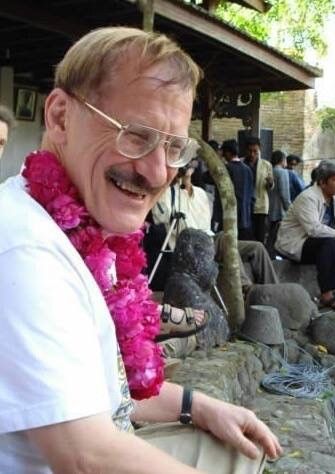
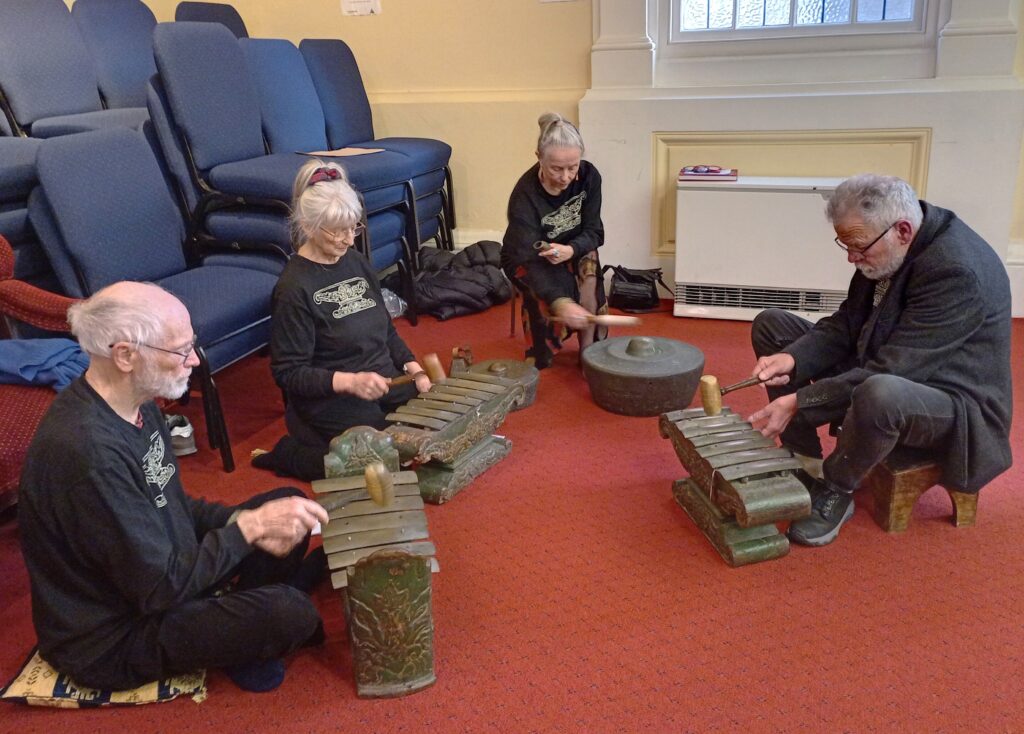
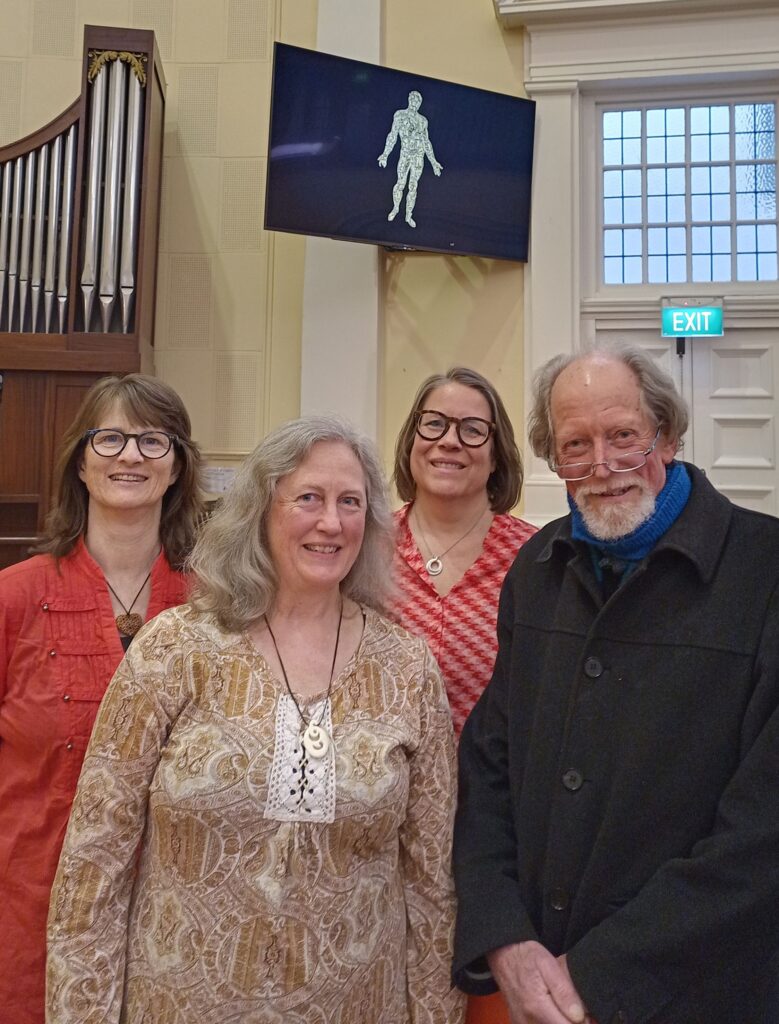
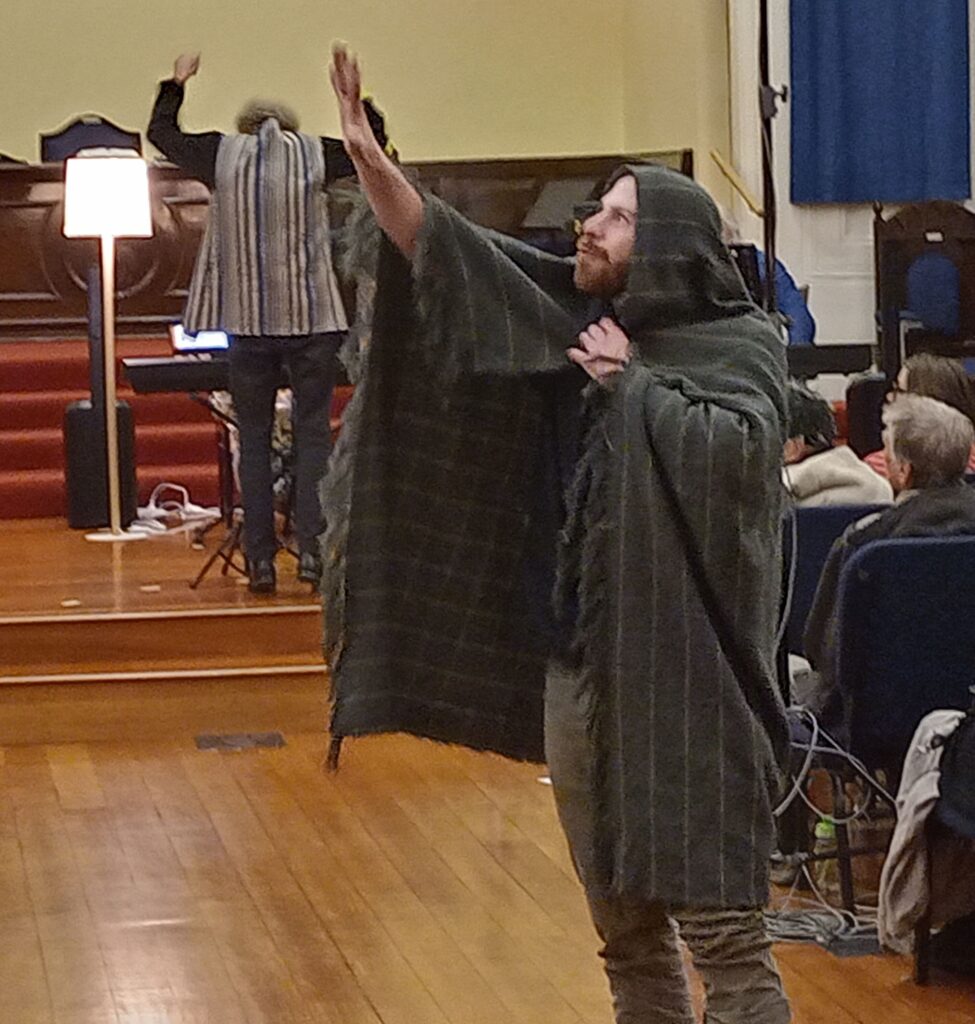 “Turtle Time” with speaker Jonathan O’Drowsky, and conductor Robert Oliver.
“Turtle Time” with speaker Jonathan O’Drowsky, and conductor Robert Oliver.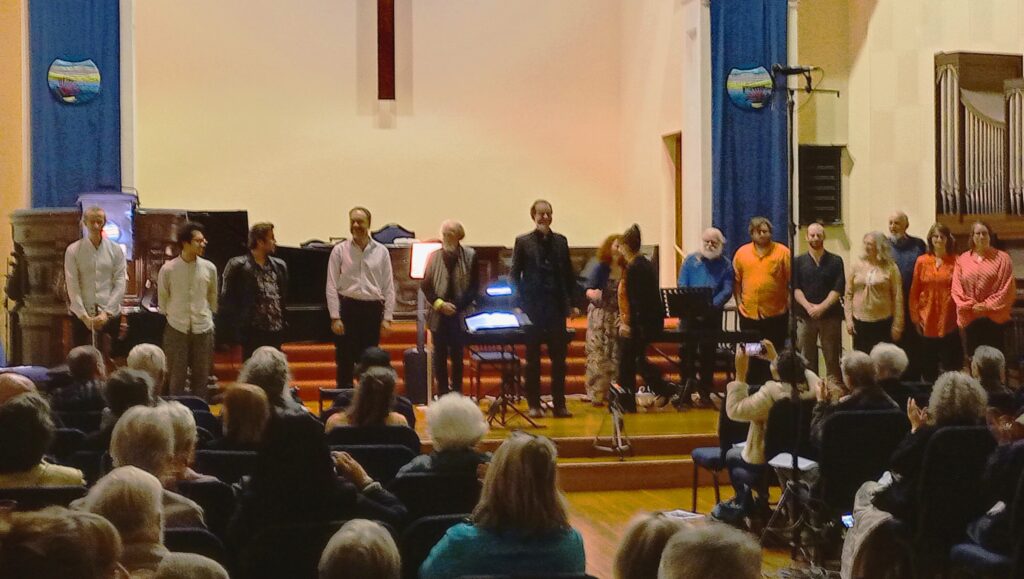 Some of the performers at the conclusion of “Jack@80” at St. Andrew’s-on-The-Terrace Church, Saturday 12th October, 2024
Some of the performers at the conclusion of “Jack@80” at St. Andrew’s-on-The-Terrace Church, Saturday 12th October, 2024